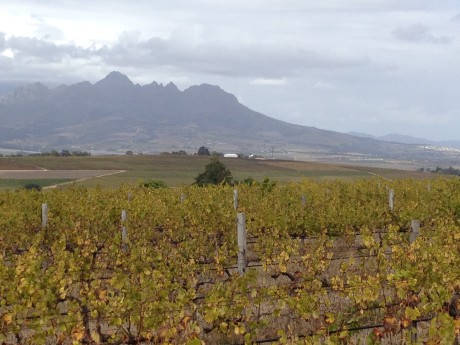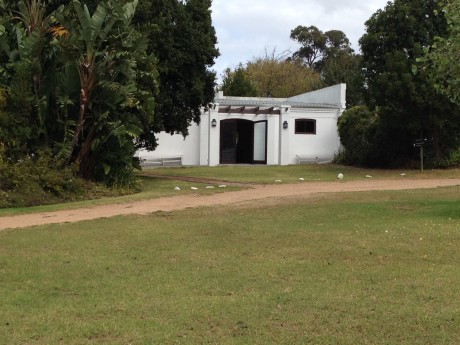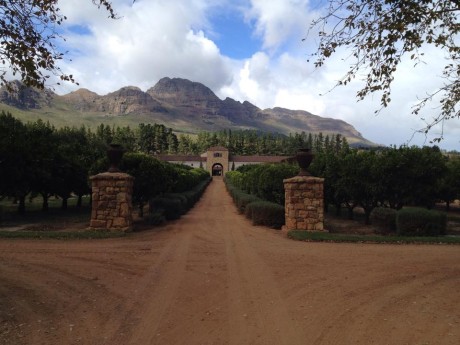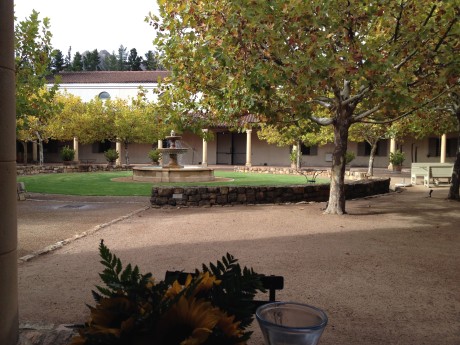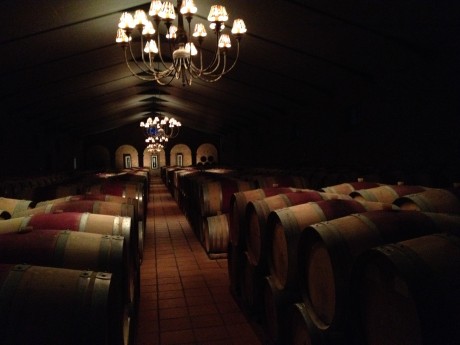Travels in South Africa: Reyneke, Waterford and Syrah v. Shiraz
Today, I’m continuing to chronicle my recent travels to various wineries throughout the Stellenbosch region with details of visits to two more producers, as well as observations on marketing of South African wines made from the Syrah/Shiraz grape variety.
Reyneke
I drove up the winding road to the hilltop location of Reyneke Wines on an overcast afternoon, but even the blustery fall day could not diminish the amazing views in every direction. The winery is unique in that it is one part of Uitzicht Farm (“uitzicht” is Dutch for “view” or “vista”), which is a working farm with ducks, cattle and crops other than grapes.
I was greeted warmly by Daniel, who manages exports for Reyneke and was my host for the tasting. He poured seven wines for me to sample: 2013 Organic White (a Sauvignon Blanc/Semillon blend), 2014 Biodynamic Sauvignon Blanc, 2013 Biodynamic Chenin Blanc, 2012 Organic Red (a Shiraz/Cabernet Sauvignon blend), 2013 Biodynamic Syrah, 2012 Biodynamic Pinotage, and 2012 Cornerstone (a Bordeaux-style blend of Cabernet Sauvignon, Merlot, and Cabernet Franc).
As I tasted through the wines, Daniel explained that Uitzicht Farm (and by extension, Reyneke Wines) adheres to biodynamic and organic farming principles, which means using sustainable and natural methods of farming rather than chemicals whenever possible. A biodynamic approach also involves using the earth’s natural rhythms to plan vineyard activities, such as fertilizing, pruning and harvesting.
In addition, Reyneke is committed to investing in the people who labor on the farm. The last wine in the flight I tasted, the 2012 Cornerstone, is produced in honor of the “cornerstone” of the farm: the workers. A portion of the profits from the sales of Cornerstone are set aside to assist with funding the purchase of homes for the workers, as well as to help with paying for the education of the workers’ children.
As I completed the tasting (and the purchase of my two favorite wines from the flight, the Sauvignon Blanc and the Syrah), I was fortunate enough to meet and have a brief chat with the owner, Johan Reyneke, to express how impressed I was with the operation of Uitzicht, the knowledgeable assistance of Daniel, and the fantastic wines being produced.
During this tasting, as well as several others, it struck me that producers in South Africa were using both “Shiraz” and “Syrah” on their wine labels, and so I asked Daniel and a few other hosts about the reasons why a winemaker (or a producer’s marketing team) might decide to use Shiraz vs. Syrah to market a wine.
Labeling a Wine “Shiraz” or “Syrah”
As you might be aware, Syrah and Shiraz are the exact same grape variety. It’s also the 2nd most widely planted red grape in South Africa. “Syrah” is the more commonly used name for the grape in most wine-producing countries around the world, with the two exceptions being Australia and South Africa. In Australia, the term “Shiraz” is nearly ubiquitous, and that apparently used to be the case in South Africa also, but in my visits to several producers, I noticed that certain wines were being labeled instead as “Syrah.” Reyneke, as well as a few other producers, had both a “Shiraz” and a “Syrah” in their offerings.
When asked about the decision on which name to use, I received several different reasons from producers. The primary reasoning was grounded in the style of the wine. The term “Syrah” is used when the wine is similar in style to the classic Syrah wines produced in the Northern Rhône region of France, which are earthy, smoky and high in tannins. “Shiraz” is used when the wine characteristics are ripe, fruity, and low in tannins, which is more typical of the Australian style.
Another reason cited was brand consistency: the winery had always used one term or the other, and stuck with it. However, one producer I visited specifically changed their labeling on their entire line from “Shiraz” to “Syrah” in 2012 due to the stylistic differences noted above.
Yet another explanation I was given was about the sound and connotation of each term. “Shiraz” is viewed as a newer and edgier term, whereas “Syrah” is perceived as elegant and sophisticated, which might again be somewhat of an extension of the primary stylistic driver.
In any case, it was an interesting discussion topic in which to engage my tasting hosts, and will likely continue to evolve as the wine industry in South Africa continues to grow and prosper.
Waterford
Driving up to the winery at Waterford is a breathtaking experience. The winding driveway leads through beautifully manicured grounds to two stone pillars which mark the entrance to the winery. From the entrance, you see Helderberg Mountain looming in the background as you pass through a tree-lined drive with a view through a stone arch of the courtyard fountain, which serves as the iconic symbol for Waterford’s wines.
Even though it was a crisp fall morning, I wrapped up in my sweater and scarf, and conducted my tasting outside in the courtyard. My young and eager tasting host was Brandon, who had been working at the winery only a short time, but whom I later found out had grown up on the farm, as his parents both work at Waterford.
Brandon poured eight wines for tasting, the last three of which were paired with chocolates (as noted): 2014 Waterford Estate Rose-Mary, 2014 Pecan Stream Sauvignon Blanc, 2014 Pecan Stream Chenin Blanc, 2013 Waterford Estate Chardonnay, 2011 Pecan Stream Pebble Hill (a blend of Shiraz, Mourvedre, Merlot, Sangiovese and Grenache, 2011 Kevin Arnold Shiraz (paired with a Masala Chai 70% dark chocolate), 2011 Waterford Estate Cabernet Sauvignon (paired with 70% dark chocolate with sea salt), and non-vintage Waterford Family Reserve Heatherleigh (paired with a Rose-Geranium milk chocolate).
My favorite wine was the Cabernet Sauvignon, which had a lovely structure, just the right amount of oak, notes of pepper and baked cherry, and a smidge of Cabernet Franc (5%) and Merlot (6%) to smooth out the rough, tannic edges. The sea salt chocolate pairing made the wine even more appealing, and I procured a bottle to take home for the cellar in Austin.
The most unique wine was the Heatherleigh, a dessert wine made with a solera process (in which a series of barrels are used to mix wine from older vintages with newer vintages, and is the same process used to produce sherry in Spain) from 60% Muscat and 40% of Chardonnay, Sauvignon Blanc and Riesling. The wine is a combination of the first names of the wives of the two owners, and as Brandon joked, “If you’re going to name a wine after your wife, it better be sweet.” (Ha.) I wasn’t sure how the wine would pair with the rose and geranium chocolate, but it turned out to be an inspired combination.
After the tasting, Brandon gave me a short tour of the winery, which was built using quarried local bedrock, as well as stones and timber from the estate. The most stunning room was the red wine barrel room, which they’ve nicknamed “The Cathedral” – and you can see why:
Until next time, cheers!

